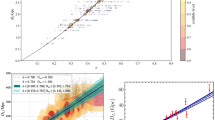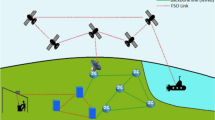Abstract
This document presents the transmit diversityconcept adopted for the FDD mode of the thirdgenerationWCDMA system in ETSI in 1998. The open-loop mode isbased on the space-time block code attaining full diversity order with two transmit antennas.Different feedback modes are specified. They all utilizeterminal measurements in controlling the transmitweighting in the transmit antennas. The concept is described in detail for two transmit antennas.It is shown that very limited feedback from the terminalto the base, as defined for the FDD mode, can increasedownlink performance significantly when compared to single-antenna transmission.
Similar content being viewed by others
REFERENCES
S. M. Alamouti, A simple transmit diversity technique for wireless communications, IEEE Journal on Selected Areas in Communications, Vol. 16, No. 8, October, 1998, pp. 1451–1458.
K. Ban, M. Katayama, W. Stark, T. Tamamoto, and A. Ogawa, Convolutionally coded DS/ CDMA system using multi-antenna transmission, '97, Phoenix, Arixona, Nov. 1997.
V. M. DaSilva and E. Sousa, Fading resistant transmission from several antennas, '95, Toronto, Canada, 1995.
W.-L. Kuo and M. P. Fitz, Design and analysis of transmitter diversity using intentional frequency offset for wireless communications, IEEE Transactions on Vehicular Technology, Vol. 46, No. 4, November 1997, pp. 871–881.
J.-L. Guey, M. P. Fitz, M. R. Bell, and Y. Kuo, Signal design for transmitter diversity wireless communication systems over Rayleigh fading channels, IEEE Transactions on Communications, forthcoming.
A. Hiroike, F. Adachi, and N. Nakajima, Combined effects of phase sweeping transmitter diversity and channel coding, IEEE Transactions on Vehicular Technology, Vol. 41, No. 2, May 1992, pp. 170–176.
A. Narula, M. Trott, and G. Wornell, Information-theoretic analysis of multiple-antenna transmission diversity, Proc. Int. Symp. Inform. Th. Appl., Canada, Sept. 1996.
H. Olofsson, M. Almgren, and M. Höö, Transmitter diversity with antenna hopping for wireless communication systems, Proceedings of IEEE Vehicular Technology Conference, Phoenix, Arizona, May 1997.
D. Gerlach and A. Paulraj, Adaptive transmitting antenna arrays with feedback, IEEE Signal Processing Letters, Vol. 1, October 1994, pp. 150–152.
A. J. Paulraj and C. B. Papadias, Space-time processing for wireless communications, IEEE Signal Processing Magazine, November 1997, pp. 49–83.
G. Raleigh and J. M. Cioffi, Spatio-temporal coding for wireless communication, IEEE Transactions on Communications, Vol. 46, No. 3, March 1998.
N. Seshadri and J. H. Winters, Two signaling schemes for improving the error performance of frequency-divisi on-duplex (FDD) transmission systems using transmitter antenna diversity, International Journal of Wireless Information Networks, Vol. 1, No. 1, 1994.
V. Tarokh, A. Naguib, N. Seshadri, and A. R. Calderbank, Spacetime codes for high data rate wireless communications: performance criteria, Proc. IEEE International Conference on Communications, Montreal, Canada, June 1997.
V. Tarokh, H. Japarkhani, and A. R. Calderbank, Space-time clock coding for wireless communications: theory of generalized orthogonal designs, submitted to IEEE Transactions on Information Theory, 1998.
V. Weerackody, Diversity for the direct-sequence spread spectrum system using multiple transmit antennas, Proceedings of IEEE International Conference on Communications, Geneva, Switzerland, 1993.
J. H. Winters, Switched diversity with feedback for DPSK mobile radio, IEEE Transactions on Vehicular Technology, Vol. 32, February 1983, pp. 134–150.
A. Wittneben, A new bandwidth effi cient transmit antenna modulation diversity scheme for linear digital modulation, Proceedings of IEEE International Conference on Communications, Geneva, Switzerland, 1993, pp. 1630–1634.
3GPP RAN WG1, Physical LayerÐ General Description, v. 2.0.0, April 1999.
EIA/TIA Interin Standard, Cellular system dual-mode mobile station-base station compatibility standard: IS-95, TIA, 1992.
Rights and permissions
About this article
Cite this article
Wichman, R., Hottinen, A. Transmit Diversity in the WCDMA System. International Journal of Wireless Information Networks 6, 171–180 (1999). https://doi.org/10.1023/A:1018851905055
Issue Date:
DOI: https://doi.org/10.1023/A:1018851905055




